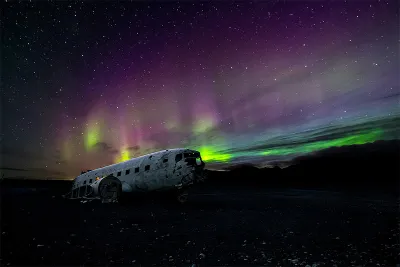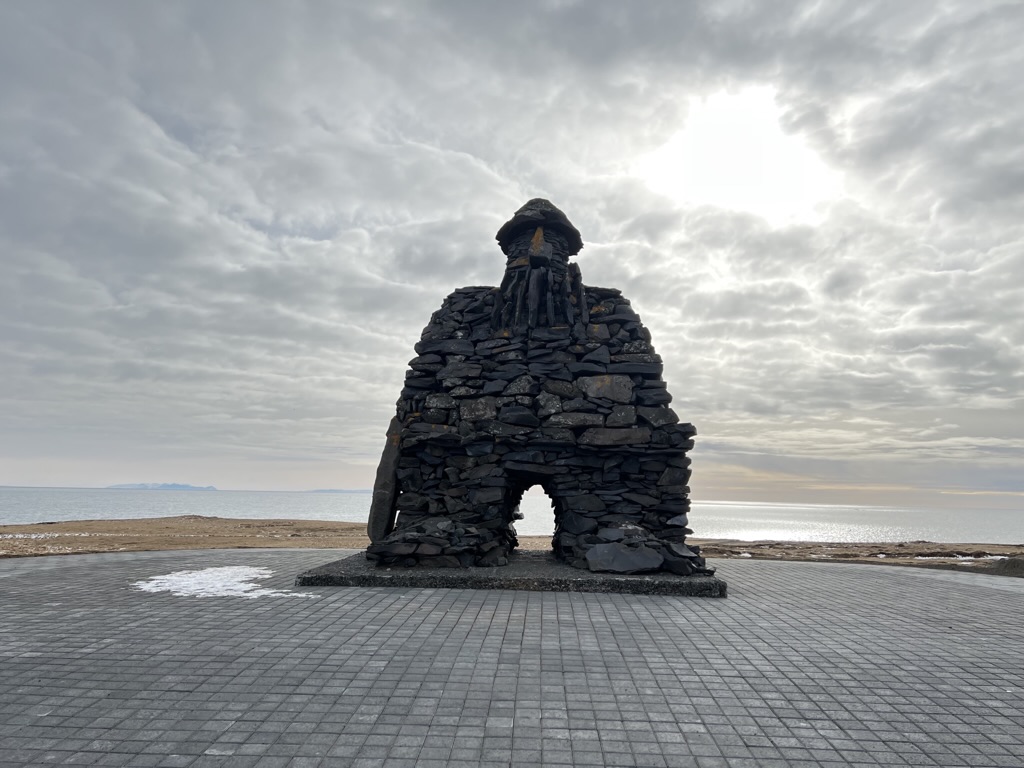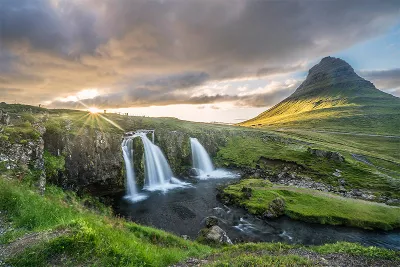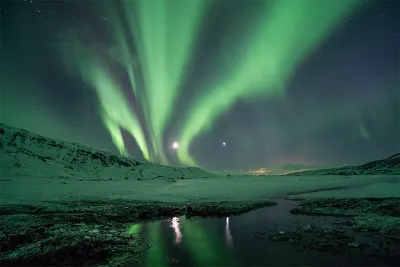Thinking of traveling to Iceland? Iceland is known as the Land of Fire and Ice and has popularly become one of the top travel destinations over the past few years. Before you plan your trip to Iceland it’s good to know some basic facts about Iceland. Iceland has everything to offer from a vast number of volcanos, lava fields, and craters to an abundance of cascading waterfalls and magnificent glaciers to mystical northern lights dancing before you in the sky and numerous black sand beaches with its distinct rock formation. It is easy to see why, travelers are so intrigued by the country. There are many features about this country that are different and might seem odd to you. Below is a list of 22 interesting facts about Iceland that you might not have heard of.
Iceland is the youngest landmass & the last country to be settled
It is believed that Iceland is one of the youngest landmasses in the world and has been one of the last countries to be settled by humans. The country was discovered by accident by a Viking named Naddoddur who intended to sail to the Faroe Islands but was blown off course and ended up in an unknown land. He went ashore and climbed a mountain, but didn’t notice any smoke, so he concluded the land was uninhabited and sailed back home to Norway and told others about his adventure. A few more Vikings attempted to sail to the country but found the Icelandic nature too harsh, so they left. It wasn’t until the 9th and 10th century Vikings settled in Iceland, mostly Norsemen and some Scandinavians with their Irish enslaved women. However, prior to their arrival, there are some traces of Irish monks who seem to have given up on the harsh living conditions and left the country.
First Parliament in Europe
The first parliament in Europe was established in 930 AD in Þingvellir National Park. The site has since then become a UNESCO World Heritage Site because of its great cultural, geographical and historical significance. This is one of the pit stops of the popular Golden Circle route along with Gullfoss Waterfall and Geysir hot spring.
Strange food tradition
Back in the days when there were no refrigerators, Icelanders used different methods to keep the meat and fish longer including smoking, urination, drying, salting and fermentation. Many of the dishes still remain part of the nation’s diet. Many of the old tradition dishes are typically eaten as stand alone dishes or upon celebrating a period of the year called ‘Þorrinn’, where people come together to celebrate the pagan festival of ‘Þorrablót’ and enjoy a buffet of strange dishes (see the image below). Among peculiar dishes are cured ram testicles, fermented rotten shark, ‘svið’ or sheep’s head, ‘sviðasulta’ or sheep’s head jelly, ‘harðfiskur’ or dried fish, two types of ‘slátur’ which are made from the fat and innards of sheep they are ‘lifrarpylsa’ or liver sausage and ‘blóðmör’ or blood pudding the latter which also contains sheep’s blood. Then you will also find a delicacy called ‘hangikjöt’ which is smoked lamb often eaten on a piece of ‘flatkaka’ or flatbread.

Strange name convention in Iceland
Contrary to other countries, majority of Icelanders don’t have a surname or family name. Of course, there are exceptions, but they are quite rare and mostly Danish which originated from foreigners marrying into an Icelandic family. Famous Icelanders who inherited a family name are for instance: Geir Haarde, former primister; Anita Briem the actress and Halldór Laxness the author. Instead it is customary for Icelanders to bear a last name that is patronymic, which is composed of their father’s name with the suffix of -son (for boys) and -dóttir meaning daughter (for girls).

Copyright Wikimedia, Creative Commons, by Max Naylor
This means, family members will have different surname, depending on their gender. Moreover, Icelandic women won’t change their name upon marrying (as they don’t become ‘son’ of their husband’s father). In recent years, some Icelander’s have a matronymic name, which is to say they have taken on their mother’s name instead of their father’s, but it is rare. Famous Icelanders with matronymic names are Björk Guðmundsdóttir the singer and Vigdís Finnbogadóttir former president. Also, there is no formality when it comes to addressing people, Icelanders are called by their first name and don’t use formal greetings like Mr. Mrs. Ms. not even for foreigners. So, if Icelanders address you without formality, don’t get offended, they are just not used to it.
Iceland is a safe country – where babies are left to sleep outside
Parents let their children play outside on the street or open areas totally unattended. Children, commonly also take their bus without a parent present. It is also not uncommon to see baby left sleeping in a pram outside a home, grocery store or café. Thus, the baby can sleep under fresh air while the parents can go about their business. While, this may seem like a neglectful behavior in many countries with high crime rates, Iceland is considered a very safe place, with incredibly low crime rate, if we ignore the financial crimes.

Unique language – the language of the Vikings
Icelandic is the official language of Iceland which like other Nordic languages belongs to the subgroup of German languages of the Indo-European language stem. Unlike most languages that have evolved tremendously over the centuries, Icelandic has kept very close to its original roots, due to hardly no outside influences up until the 20th century and extreme isolation. In fact, Icelandic remains so close to Old Norse, the language spoken during the Viking age, that Icelanders can still read and comprehend the Icelandic Sagas, a literary treasure dating back to the 13th and 14th century, without much difficulties.
There is not a single McDonald’s or Burger King restaurant in Iceland
As surprising as that may seem, Iceland is one of the few countries in the world that hasn’t got McDonald’s or Burger King restaurants. However, both chains opened in Reykjavik back in 1990’s, but following the financial crisis they disappeared. There is a chain called Metro, owned by McDonald’s which replaced it, whose menu does look like and taste quite similar. However, that is not to say Icelanders aren’t fast-food fanatics, in fact you can’t find some other American chains here like KFC, Domino’s and Taco Bell.
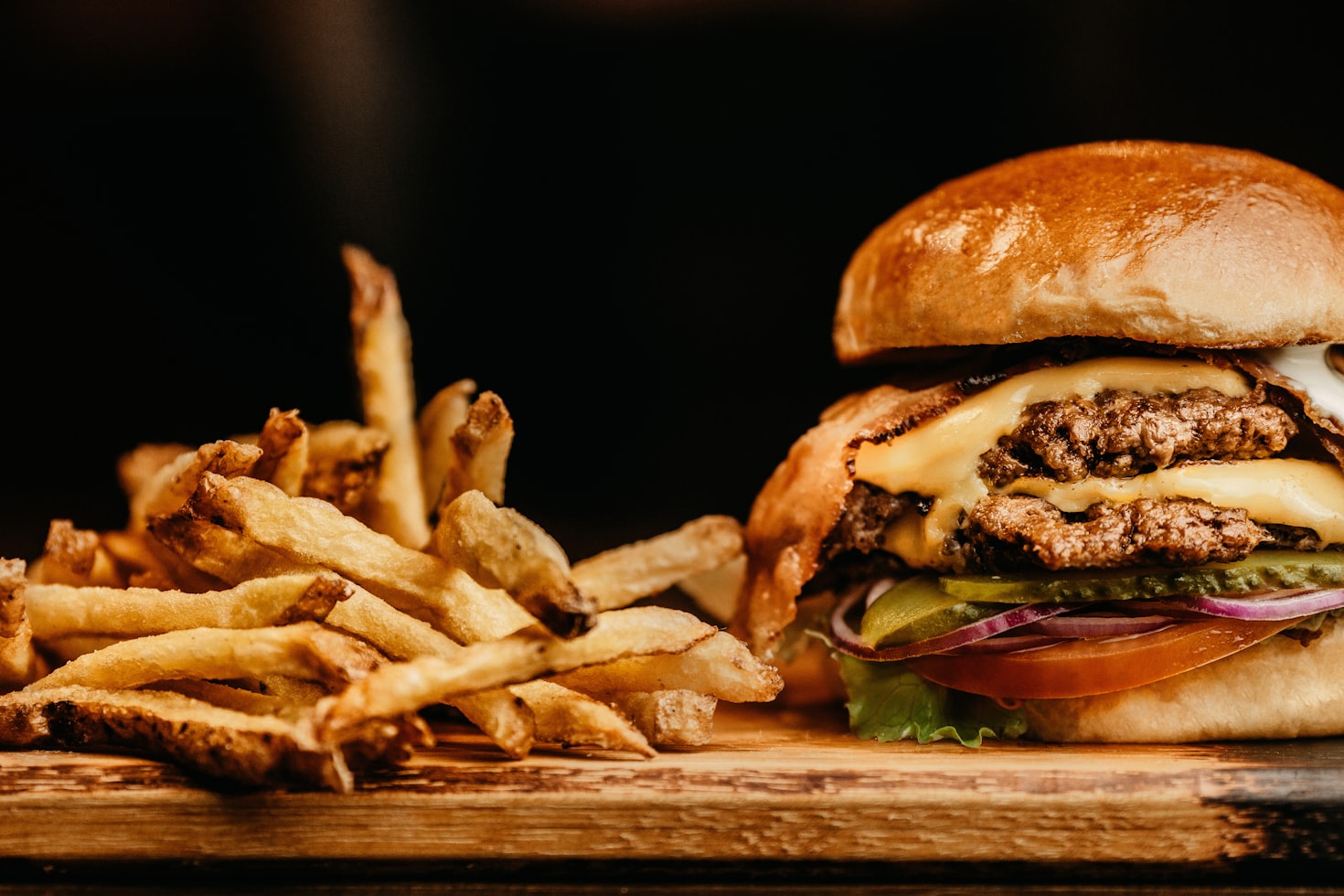
The Yule Lads – the gift giving Ogres of Iceland
Iceland is rich in folklore and contrary to Santa Clause which lives in the North Poles and travels around the world to bring gifts to children, there are 13 ‘jólasveinar’ or Yule Lads in Iceland which are sons of ‘Grýla’ and ‘Leppalúði’. These Yule Lads are said to be Icelandic ogres that come from the mountains of Dimmuborgir, north of Iceland. Initially, the Yule Lads, were mischievous pranksters that stole from people and teased them, with time they became charismatic and full of love that travelled to town 13 days before Christmas to bring gifts to the children that had been nice. In fact, Icelandic children place a shoe in their window sill and go to sleep. If, they have been nice, they are pleasantly surprised to wake up to a small gift (such as candy or toy) waiting for them in the shoe. However, those that have been naughty may receive a potato. The Yule Lads have unique characters and appearance and are named after their mischievous nature. The first one to arrive to town is Kertasníkir (the candle stealer) and the last one to arrive is Hurðaskellir (the door slammer). You can visit Litla Jólabúðin, Christmas Shop on Laugarvegur open all year round for decoration to take home.
Many Icelanders believe in Elves and Trolls
If you ask an Icelanders about the existence of Elves and Trolls, majority of them would admit with a glint in the eye to either believe or have some amazing stories to tell about these mystical creatures. According to legend, ‘Tröll’ or trolls were changed into rocks upon sunrise. There are a number of attraction sites with unique cliff formation, some of which have distinct human-like shape, which are said to be trolls before they got struck by sunlight.

As for ‘huldufólk’ (the hidden people) or elves, according to folklore and some perceptive individuals, these creatures reside in some rocks, lava fields and hills in various sites throughout the country. In fact the believe or fascination is such that some people keep statues of elves outside of their home, which is quite common in the town of Borgarnes. Also, over the centuries, under construction of roads it is not uncommon that tools have mystically gone missing or machinery broken down, so that the constructors gave up and left the stone alone or moved the construction to a different site. Many believe, this malfunction and things going missing, is due to the disturbance of Elves that have taken a revenge. So, to keep the elves on a your good site you should try not to disturb them at their residence.
Where do Elves reside and where can you find petrified Trolls in Iceland?
Among sites that are said to contain distinct rock formation which are said to be petrified trolls are: Reynisdrangar by Reynisfjara Black Sand Beach on the South Shore of Iceland, Hvítserkur cliff northwest of Iceland and Kerling or troll woman on Djúpalónssandur black sand beach on Snæfellsnes Peninsula. Dimmuborgir, a mystical place close to Mývatn, North of Iceland, is said to be the home of the ‘Yule Lads’ and their parents. Söngklettur or singing rock located on Djúpalónssandur on Snæfellsnes Peninsula and is said to be the Church of the Elves and according to folklore, on occasion you can hear them sing.
The Beer Ban in Iceland
Surprisingly, consumption of beer was forbidden for 74 yours, but the ban was lifted on March 1st 1989.. Since then, Icelanders cherish the beer and celebrate that day annually with the ‘Bjórdagurinn’ or The Beer Day. Today, there are numerous microbreweries around Iceland and you can even visit a Beer Spa in Akureyri in northern Iceland. Among great microbreweries in around Iceland: Steðji Brugghús located in Borgarfjörður, Ölvisholt in Selfoss, Ölverk in Hveragerði and Gæðingur Brugghús. As for Reykjavik, there are many pubs that offer microbeer on tab such as Brewdog, Micro Bar and Ölstofa Kormáks og Skjaldar, but there are also local breweries such as Borg Brugghús and Bastarður Brew Dog in Reykjavik.
The Northern Lights & Midnight Sun
Due to its proximity to the Arctic Circle, there are long winter nights and long summer days in Iceland, at times almost 24 hours of darkness during December and almost 24 hours of daylight in June. This makes Iceland the ideal place to witness both the fascinating Northern Lights dance across the mystical dark sky in various colors during winter and the amazing Midnight Sun during the summer months. However, due to Iceland’s ever-changing weather, sometimes it can be difficult to see.

Small population
Despite Iceland only having a small population about 341 thousand, majority of it located around Reykjavik the capital. Some might say that Icelanders suffer a bit from a small nation complex, as Icelanders proudly claim they are the best country in the world for several reasons. There has abundance of great talented musicians like Björk Guðmundsdóttir and Sigurrós, a great national Handball team and are known for strong men and beautiful women. Icelanders pride themselves of having won the Championship of the Strongest Men, several times and won the Miss World four times. Generally, Icelanders are proud, hardworking and independent people that are very friendly and have a positive attitude. There is a saying in Iceland which goes: ‘Þetta reddast’ which means, everything is going to be ok.
There are no trains in Iceland
As surprising as that sounds, Iceland has no public railway system. How is it possible? The reason being lack of funding due to small population, widespread use of cars and harsh weather conditions. Over, the years there have been speculations about establishing a railway from Reykjavik to Keflavik Airport, but only time will tell if those plans will be fruitful. In stead, people mostly rely on their car or take a public bus. The car consumption is such that there are almost as many cars in Iceland as there are people.
Icelandic water is one of the purest in the world
Iceland is blessed with abundance of water in any shape and form, from waterfalls, hot springs, lagoons to lakes and rivers. Fortunately, Icelanders have almost limitless reserve of delicious and clean water accessible straight from the tab. The Icelandic tab water contains no additives or contaminants and is not treated with any chemicals such as chlorine and therefore considered one of the purest water in the world. It comes from natural springs around the country which have been filtered through some layers of lava decades prior to reaching the tab.

Unique Icelandic Horses – from the age of Vikings
The Icelandic horses arrived with the Vikings and due to isolation and strict ban of importing other breeds, they are considered one of the purest breeds in the world. Despite their somewhat small stature, they are sturdy, versatile and hardworking horses with gentle nature that are able to endure hard winters. They are unique for their ‘tölt’ which is a special Icelandic type of gait. While most horses can only perform three of four gaits, the Icelandic horse is able to perform five types of gaits. Riding on horse in Icelandic nature is amazing experience and there are many companies in Iceland that offer Horse Riding Tours both for beginners and more advanced.

Iceland is habitat to the world largest colonies of Puffins
Iceland is the breeding ground to 8-10 million puffins and contributes to about 60% of globe’s entire Atlantic puffin population. These adorable birds, resemble penguins and by some referred to as the Icelandic penguin. They can be spotted in Iceland from as early as April to late September in areas such as Látrabjarg in the Westfjords, Dyrhólaey on the south coast, Ingólfshöfði and the Westman Islands and just outside of Reykjavik in the small islands of Akurey and Engey. There are many companies that offer Puffin Watching tours by boat. If you are in for some adventure, why don’t you try Rib Speed boat, it is faster and takes you up close to these amazing birds.

Unique Icelandic Dogs
Just as the Icelandic horse, the Icelandic Sheepdog descends from the Vikings and is special breed of dogs of the type of spitz that has evolved in isolation through the centuries. It arrived to Iceland with the settlers around 9th century and is most closely related to the Norwegian Buhund. The dog is renowned for its gentle nature and friendly manner. It is very alert and agile and being a sheepdog it is extremely useful for herding some livestock or finding lost sheep.
Iceland has mild winters
Despite what many people believe, upon hearing the name Iceland, the country is not covered with snow all year round. However, there are some glaciers which contribute to about 11% of the Icelandic landscape. It can snow from October to April, however the coldest month are typically around Christmas up to February. However, if you plan to go skiing, Iceland is not the best resort for that, as the snow is often missing. The winters in Iceland are mild thanks to the Gulf Stream which flows along the south and west coastline of Iceland, bringing in warmth originated from the Caribbean. However, as this warmth mixes with the cold Arctic air from the north it leads to sudden and frequent weather changes like storms and rain.
Iceland has no mosquitos
Iceland is free from mosquitos so there is no need to bring insect repellents. However, unfortunately, Iceland does have small biting midges or sand flies, which can be very annoying. If you are travelling around Mývatn area you are bound to find many of them during the summer. So, a fly net is recommended to bring on the travel.
Iceland has hardly no forests
This might seem strange to many people. Upon the arrival of the Vikings, it is estimated that about 40% of the country was still forested, however today, sadly only about 1% of the countryside is forested. What happened? The Vikings needed wood to burn charcoal and to build their boats, buildings and fences to survive over the cold winters. In fact, a few centuries after the settlements of the Vikings, Iceland proved to be the worst example of deforestation ever on record. However, let’s not forget that Iceland is one of the youngest landmasses on Earth and at the time it was discovered, it was a very vulnerable ecosystem which wasn’t quite ready for the invasion of humans and its livestock. Currently, afforestation is in place and approximately three million seeds are planted each year. The main forests in Iceland are: Hallormsstaðaskógur in the East, Kjarnaskógur in Akureyri and Öskjuhlíð in Reykjavik.
Iceland – the top ranked eco-friendly country in the world
Iceland is blessed with an abundance of clean and sustainable energy powered from hydro- and geothermal resources and truly deserves to be called the Land of Ice and Fire. When it comes to energy sources, Iceland is the most eco-friendly country in the world. Nearly all electricity in Iceland comes from renewable energy or 99%, of which 73% of the electricity is provided by hydropower plants and 27% from geothermal energy. Icelanders are also pioneers when it comes to heating up houses and spaces with sustainable energy, as up to 90% of Icelandic households use geothermal water to heat up their homes. You can learn about the process of harnessing electricity through hydro- and geothermal energy at Hellisheiði Powerplant. There you can also see how carbon dioxide from the air is transformed into rocks.
